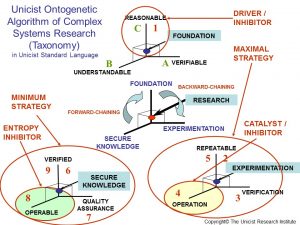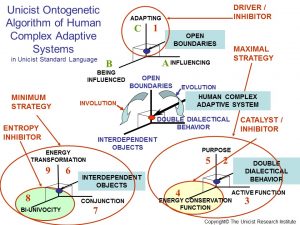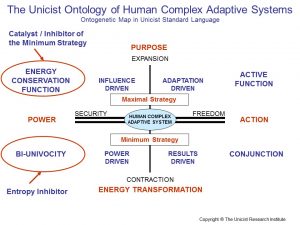Introduction to Complexity Science Research
The unicist theory expanded the frontiers of sciences making the scientific approach to complex adaptive systems possible without needing to use arbitrary palliatives to transform complex systems into systemic systems in order to be able to research them.

The Unicist Research Institute has changed the paradigms of complexity research. Click on the image to enlarge.
Paradoxically, this is a breakthrough and a back to basics. On the one hand, it is a breakthrough because it changed the paradigms of scientific research. On the other hand, it is a back to basics because it drives sciences to deal with the nature of reality.
The unicist logical approach opened the possibilities of managing complexity sciences using a pragmatic, structured and functionalist approach.
The unicist approach to complexity is based on the research of the unicist ontological structure of a complex adaptive system which regulates its evolution. This is based on emulating the structure of the unicist ontogenetic intelligence of nature considering that every functional aspect of reality has a unique unicist ontological structure.
The approach to ontological structures of reality requires going beyond the dualistic thinking approach and being able to use the double dialectical logic to approach complex adaptive systems.
The research in complexity science needs to have its own format for its presentation that has a structural difference with the papers for systemic sciences (abstract, introduction, materials and methods, discussion, literature).
Abstract
There are many operational definitions of complex adaptive systems. They have been considered as an input to develop the ontology of human complex adaptive system. The research to define this ontology demanded more than 30 years until it was published. In the meantime operational definitions of the systems were used until they could be validated and transformed into an ontology.
There are two controversial aspects which in this approach are a consequence and not an ontological characteristic of the system:
- Emergence
- Observers
1) By definition a human complex adaptive system needs to be approached in its oneness and therefore the results is the only valid measurement of the effectiveness. That is why emergence has not been considered as an element of the system.
2) As the system has open boundaries, there is no possibility of the existence of observers; they are implicitly part of the system.
That is why the apprehension of a complex adaptive system needs to be validated by multiple accurate forecasts.
Complex Adaptive Systems Research
The Unicist Ontogenetic Algorithm defines how empirical approaches are transformed into logical solutions.
The discovery of the unicist ontogenetic intelligence of nature and the ontological research done on complex adaptive systems allowed the development of the Unicist Ontogenetic Algorithm.
The Unicist Ontogenetic Algorithm of Evolution
When an individual is in an evolution cycle there is no risk of failure. The individual makes all the necessary actions to ensure evolution. Human efficacy depends on the fundamental driver of individuals.
Efficacy requires fallacious free actions. The research on human evolution included finding the natural taxonomies of evolution and involution.
Involution implies a degradation of the purpose of an individual in order to reduce the energy required to deal with reality.
When dealing with complex problems it is frequently seen how individuals avoid responsibility replacing the original purpose with a subordinated objective in order to “ensure” success.
The unicist algorithm (taxonomy) of evolution
 Evolution implies the existence of an algorithm (taxonomy) to achieve a purpose. The first step appears to be putting the purpose into action. This implies a previous taxonomic step: the understanding of the purpose. Then the first step is putting it into action. Without understanding, no action is possible.
Evolution implies the existence of an algorithm (taxonomy) to achieve a purpose. The first step appears to be putting the purpose into action. This implies a previous taxonomic step: the understanding of the purpose. Then the first step is putting it into action. Without understanding, no action is possible.
The second step is then finding a way to optimize the energy; thus the energy conservation principle is applied.
When this taxonomy is respected and successful, individuals are evolving. This implies that they add value to the environment, obtain the counterpart and learn from the environment at the same time.
Evolution implies being aware of reality and doing conscious actions in order to adapt to the environment.
The Unicist Ontogenetic Algorithm of
Complex Systems Research
Complex systems are studied seeking the foundation through experimentation based on preexisting secure knowledge.
This implies that the purpose of a research work is to build foundations that will eventually be used in the diagnosis in order to exert influence on a given reality.
 Research necessarily implies experimentation, which must allow repetition. That is to say, regardless of the number of times that the experience is carried out the result should always be the same.
Research necessarily implies experimentation, which must allow repetition. That is to say, regardless of the number of times that the experience is carried out the result should always be the same.
Results from experimentation must be verifiable, that is, they have to be susceptible of being measured objectively, subjectively or through forecast.
In addition, the experimentation of the complex system under study must “work”, that is, this should be a real activity that produces a result for which such system has been designed. To work means an actual activity that cannot be simulated.
Research is based on preexisting secure knowledge. This knowledge must have quality assurance, be operable and verified.
Research on complex systems cannot be built on the basis of hypothetic knowledge. When there are only hypothesis then real foundations cannot be reached, instead, hypothetical foundations are built.
Unicist Ontogenetic Algorithm (taxonomy)
- Define the type of foundations you need to fulfill the objectives
a) Define with which logical approach you will reason the problem.
b) Define how you will verify the validity of the foundations.
c) Define the intrinsic logic needed by the foundations you are looking for. - Define how experimentation can be repeated in analogous / homologous fields.
- Define the verification of the facts you are experimenting.
- Define the operation to develop the experimentation.
- Confirm the repeatability of the experiments.
- Define the conditions of valid knowledge.
- Define how you will assure the quality of the knowledge you produced or used.
- Confirm the operability of the knowledge.
- Define the conditions of secure (reliable) knowledge.
- Define the destructive and non-destructive pilot tests of the research method.
The use of the unicist ontogenetic algorithm requires the quantification and qualification of each of its components (see mathematics of the unicist logic) and the use of destructive and non-destructive pilot tests to confirm the functionality of the solution that was developed.
Pilot tests and the final implementation of a strategy have to follow the steps of the unicist ontogenetic algorithm.
The Research of Human Complex Adaptive Systems
Essentially, human complex adaptive systems are those that have open boundaries, have a double dialectical behavior and are integrated by interdependent objects.
 The open boundaries of these systems are defined by their adaptation capacity, the influence they can exert on the environment and the influence from the environment they need to absorb.
The open boundaries of these systems are defined by their adaptation capacity, the influence they can exert on the environment and the influence from the environment they need to absorb.
The double dialectical behavior implies that complex adaptive systems behave following the structure of the ontogenetic intelligence of nature, meaning that they have a purpose, an active function and an energy conservation function.
The interdependent objects produce the necessary energy transformation in an environment where all the elements are integrated by conjunctions and have multiple bi-univocal relationships.
The algorithm to research human complex adaptive systems requires to:
- Apprehend the open boundaries
a) Understand how influence is exerted
b) Understand the external influence the system needs to deal with
c) Understand the adapting process of the system - Understand the true purpose of the system
- Understand the action of the system to extend the boundaries
- Understand the energy conservation function to sustain the extension of the boundaries
- Confirm the purpose after having apprehended its expansive dynamics
- Understand how the system transforms the energy to achieve its goal to adapt in an open boundaries driven environment
- Understand the conjunction of the objects and their functionality
- Understand the bi-univocal interdependence of the objects and their consequence
- Confirmation of the energy transformation produced within the system
- Develop destructive and non-destructive pilot tests to confirm the knowledge
This static research provides they hypothesis of the ontological structure of a human complex adaptive system. After this static research has been finished it is necessary to begin the dynamic research following the research methodology which is:
- Develop the hypothetical structure of the ontology.
- Analyze the ontology and divide it into sub-ontologies following the laws of complementation and supplementation (only when necessary and possible).
- Define the observable results needing to be considered to validate the ontology.
- Define the application fields of the ontology to validate its functionality.
- Develop the applications beginning with destructive and non-destructive pilot tests to forecast reality.
- Develop at least five experiences in the application field differing completely one from the other.
- Develop forecasts of at least three periods with full certainty.
- Restart the research process every time a deviation occurs.
Categories of Human Complex Adaptive Systems
 The categories of these systems can be synthesized in the following logical structure:
The categories of these systems can be synthesized in the following logical structure:
Results driven systems
These are the systems that have been designed to produce materialistic results. Businesses are an example of this category. This category needs to close the boundaries as far as it is possible minimizing the influence exerted by the environment to produce the defined results.
Power driven systems
These systems have been designed to exert power. Political parties are an example of this category. This category needs to minimize the adaptation process to the environment in order to maximize the power they have.
Influence driven systems
They have been designed to exert influence on the environment. Institutions, whatever their objective, are an example of this category. They exert influence through their transcendent goals. They need to minimize the short term results in order to sustain the influence they exert through their long term goals.
Adaptation driven systems
They are systems that are designed to adapt instantly to the environment. Entrepreneurs, whatever their type (social, business, ideological), are an example of this category. These systems adapt through the capacity of adaptation of their members, leaving aside the goals of the system itself.